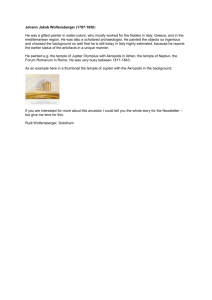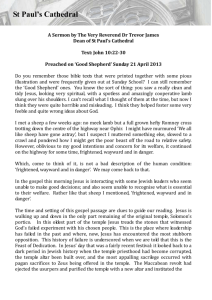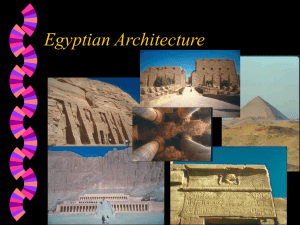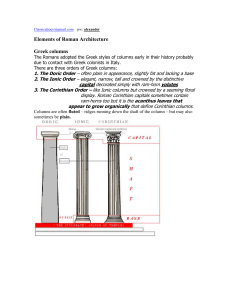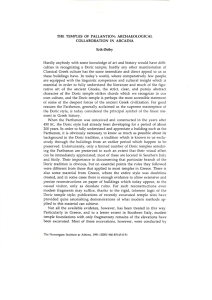ROMAN RECTANGULAR TEMPLES
advertisement
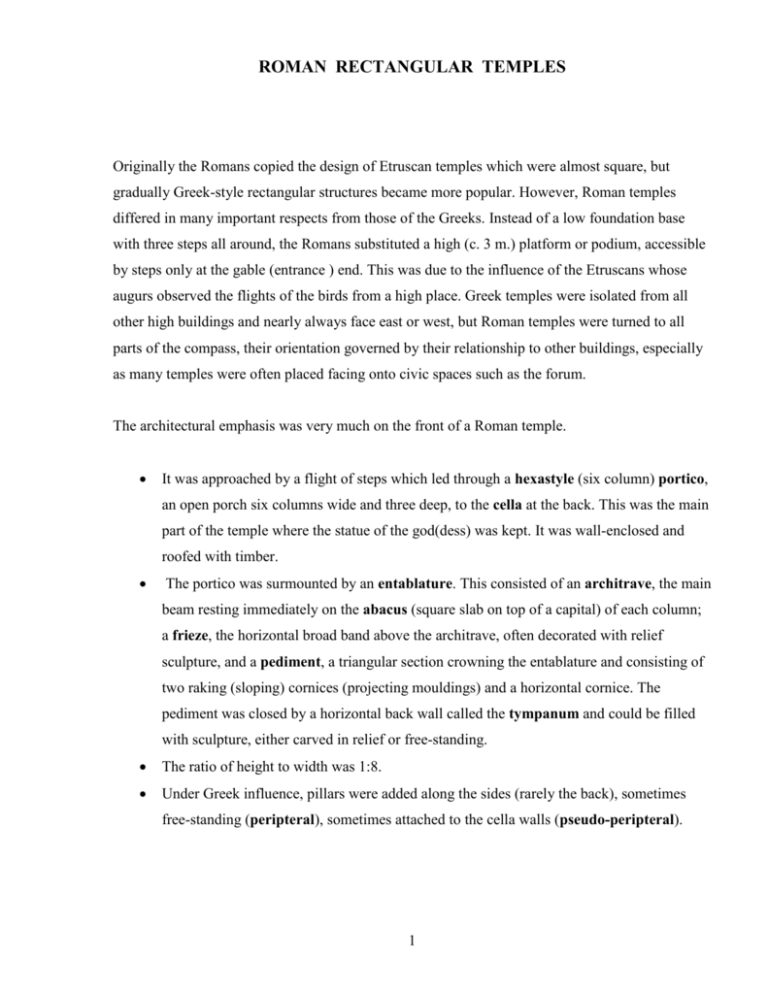
ROMAN RECTANGULAR TEMPLES Originally the Romans copied the design of Etruscan temples which were almost square, but gradually Greek-style rectangular structures became more popular. However, Roman temples differed in many important respects from those of the Greeks. Instead of a low foundation base with three steps all around, the Romans substituted a high (c. 3 m.) platform or podium, accessible by steps only at the gable (entrance ) end. This was due to the influence of the Etruscans whose augurs observed the flights of the birds from a high place. Greek temples were isolated from all other high buildings and nearly always face east or west, but Roman temples were turned to all parts of the compass, their orientation governed by their relationship to other buildings, especially as many temples were often placed facing onto civic spaces such as the forum. The architectural emphasis was very much on the front of a Roman temple. It was approached by a flight of steps which led through a hexastyle (six column) portico, an open porch six columns wide and three deep, to the cella at the back. This was the main part of the temple where the statue of the god(dess) was kept. It was wall-enclosed and roofed with timber. The portico was surmounted by an entablature. This consisted of an architrave, the main beam resting immediately on the abacus (square slab on top of a capital) of each column; a frieze, the horizontal broad band above the architrave, often decorated with relief sculpture, and a pediment, a triangular section crowning the entablature and consisting of two raking (sloping) cornices (projecting mouldings) and a horizontal cornice. The pediment was closed by a horizontal back wall called the tympanum and could be filled with sculpture, either carved in relief or free-standing. The ratio of height to width was 1:8. Under Greek influence, pillars were added along the sides (rarely the back), sometimes free-standing (peripteral), sometimes attached to the cella walls (pseudo-peripteral). 1 THE MAISON CARRÉE The best preserved example of a Roman rectangular temple is the Maison Carrée at Nîmes in southern France, built by Augustus’ chief military advisor and son-in-law, Marcus Agrippa. The temple was built around 16BC and was dedicated to Agrippa’s two sons, Caius and Lucius. The date is fixed by traces of the original inscription on the front frieze and architrave. The bronze letters have long disappeared, but the nail holes remain. The temple is externally complete except that originally the surviving podium stood on a platform surrounded by porticoes (roof attached to a building on one side and supported by pillars at frequent intervals on the other) which formed the forum of the Roman settlement, Colonia Augusta Nemausis. Built from local limestone (the workmen and architect came from Rome), the Maison Carrée stands on a 2.7m. high podium which is enclosed by a plinth (projecting wall) that extends beyond the porch to enclose the flight of steps. Fifteen steps lead up to a hexastyle portico of the Corinthian order, surmounted by an entablature. The pillars are around 10m. in height. The relief carving of acanthus leaves on the frieze is copied from the Ara Pacis Augustae at Rome. The Maison Carrée measures c.26m. from the front portico pillar to the back wall and is 13m. wide. The ratio of the short to the long sides is almost 1:2 (6:11 pillars). The deep porch faces north with three clear bays (openings between pillars) on each side and it takes up almost one third of the building’s total length. The temple is pseudo-peripteral, having seven engaged pillars on either side and six at the rear end. The Maison Carréis an elevated, rectangular , hexastyle, pseudo-peripteral Roman temple of the Corinthian order. Wheeler: Photo, p.92. 2 THE TEMPLE OF BACCHUS AT BAALBEK The temple of Bacchus at Baalbek in the Lebanon dates from c.150AD. The dimensions of the building are 35 x 66 m. It is a peripteral temple with 15 columns on each side and 8 back and front. The structure stands on a high podium with a flight of 34 steps leading up to the deep hexastyle prostyle (front only) portico. The larger (17m.) are unfluted and of the Corinthian order while the smaller ones in the portico are fluted Corinthian. The ceiling of the peripteral portico is convex and is richly coffered and decorated with framed busts of Mars, Ceres, Vulcan and other deities. The huge entrance door (6.3m. wide and 12.6m. high), with its elaborately decorated frames, is flanked by two towers which carry stairs up to roof level – for what purpose is disputed, though the same feature occurs in a number of temples in the Middle East, Sicily and southern Italy. The lavishly decorated interior of the temple is in sharp contrast to the bare austere or extrovert Greek tradition. Inside the cella is flanked by Corinthian pilasters set on pedestals and flanked by Corinthian half-pillars. Between the pilasters are two tiers of niches, the lower one arched, the upper one having triangular pediments. The upper niches at least once contained statues. Above the main pilasters ran a complete engaged entablature, carried forward over the plasters. Threequarter way down the cella began a podium which ran across the width of the building and which was approached by a flight of 9 steps. Beyond this a second set of 6 steps leads to a still higher platform on which stands an elaborate baldachin (canopy or roof-like projection over an altar, throne, bed), supported by two massive deep pilasters and containing the cult statue. Wheeler, p.96: “The whole concept was astonishingly rich – the stone, observed Lamartine, ‘groaned beneath the weight of its own luxuriance’ – and, as the most nearly complete surviving example of its kind, the building holds a unique place in the history of architecture.” Wheeler: Plan: p.93. Photos: pp94-96. Reconstruction of interior: pp. 98-99. 3






